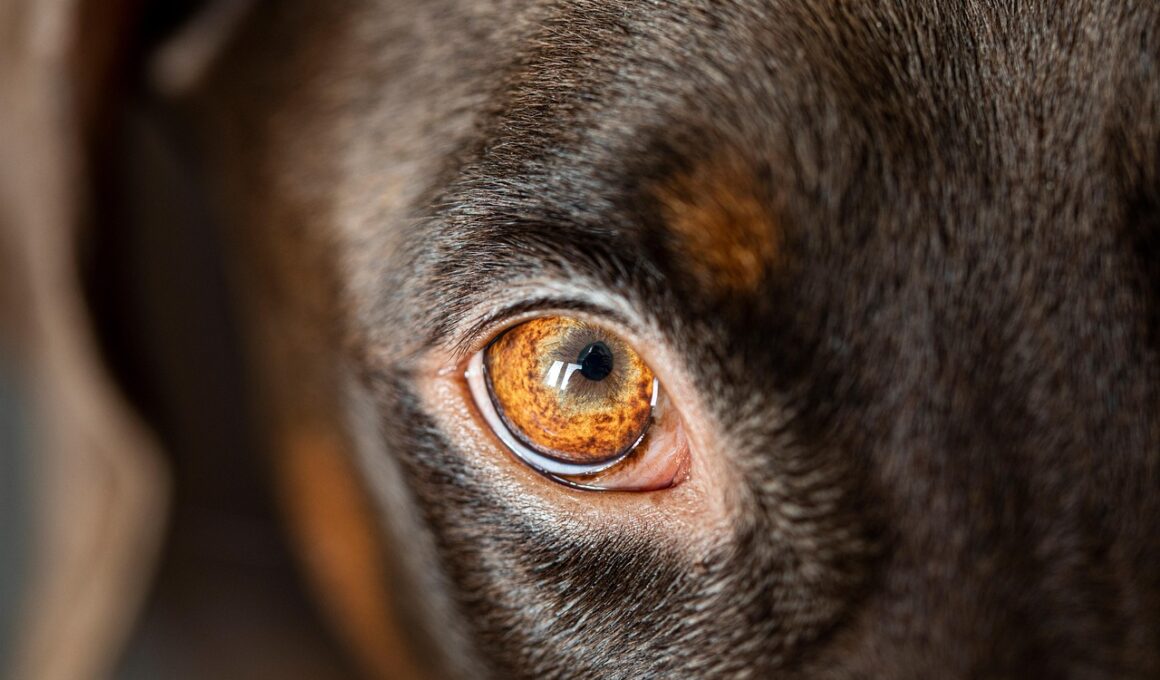Diagnosing Dry Eye in Dogs: Tests and Procedures Explained
Dry Eye, scientifically known as Keratoconjunctivitis Sicca, is a condition that affects many dogs, leading to discomfort and potential vision issues. When diagnosing this condition, veterinarians rely on several tests to determine the adequacy of tear production. The primary test employed is the Schirmer Tear Test, where a small strip of paper is placed in the dog’s eye, and the wetting of the strip is measured over five minutes. This test informs the vet about the tear production levels. Low values indicate possible dry eye. In addition to this, a thorough examination of the eye’s surface using an ophthalmoscope helps evaluate potential damage and signs of inflammation. Owners may notice signs such as redness, excessive blinking, or discharge in their dog, which can prompt them to seek veterinary help. It’s crucial for pet parents to recognize these signals and act quickly. Regular check-ups are ideal for catching such issues early. Understanding the tests required for dry eye diagnosis can significantly improve the health and comfort of our furry friends.
Alongside the Schirmer Tear Test, additional assessments play a vital role in diagnosing dry eye in dogs. The tear film break-up time test, for instance, assesses the stability of the tear film by measuring how long it takes for the first dry spots to appear after a blink. A shortened tear film break-up time indicates inadequate tear production and can signify dry eye. Additionally, veterinarians may use a fluorescein stain to check for corneal ulcers or other abnormalities that may result from chronic lack of moisture. This test involves applying a green dye to the eye, where it will highlight any damaged areas on the cornea. To ensure a comprehensive assessment, it’s important that the vet combines these tests with a detailed medical history of the dog, taking into account any previous eye conditions, medications, or environmental factors. It is vital for dog owners to proactively discuss any noticeable changes with their vet, ensuring appropriate exams are carried out. Proper diagnosis is essential for effective treatment and management of this irritating condition.
Importance of Early Diagnosis
Early diagnosis of dry eye in dogs is critical as it can significantly impact treatment outcomes and quality of life. Conditions like Keratoconjunctivitis Sicca, if left untreated, can lead to chronic pain, severe discomfort, and potential vision loss. The longer the condition persists without appropriate intervention, the higher the risk of secondary infections, which can complicate treatment. Prompt diagnostics help ascertain the severity of dry eye and rule out other conditions that may mimic similar symptoms, thus avoiding misdiagnosis. Treatments can range from artificial tears to surgical options, such as punctal occlusion, which effectively helps retain tears. In severe cases where other methods are ineffective, medication to stimulate tear production may be necessary. Early action also allows dog owners to be proactive in monitoring adjustments to their dog’s environment, which can help mitigate worsening symptoms. Moreover, maintaining regular check-ups post-diagnosis ensures that the prescribed treatment is effective and allows for timely adjustments. Overall, early intervention ensures a better prognosis and enhances the dog’s wellbeing.
Veterinarians recommend following specific protocols when diagnosing dry eye to ensure thorough examination and understanding of the dog’s condition. During the initial consultation, vets will likely perform a complete eye examination, looking for signs of conjunctivitis, corneal damage, or any foreign bodies. This examination often includes a review of the dog’s overall health history to identify potential contributors to dry eye. Understanding any systemic illnesses, such as autoimmune conditions, can help direct treatment. Moreover, diagnostic imaging might be employed in some cases to visualize underlying issues that could affect the tear glands. Veterinarians may also provide recommendations for home care that help ameliorate symptoms, such as environmental adjustments or applying prescribed eye drops more frequently. Maintaining good hydration, ensuring a clean environment, and reducing exposure to irritants will undoubtedly benefit the dog’s eye health. Owners play a critical role in monitoring their dog’s behavior and overall condition, making their observations invaluable during veterinary visits so that it can help focus on appropriate tests or treatments needed for effective management of dry eye.
Potential Complications
While diagnosing dry eye is fundamental, it is also important to recognize and understand the potential complications that can arise from untreated conditions. Chronic dry eye can lead to corneal ulcers, scarring, and persistent inflammation, all of which may result in vision impairment or loss if not effectively addressed. Furthermore, prolonged issues might trigger an overproduction of tears in response to irritation, which seems contradictory but can complicate treatment approaches. Managing concurrent infections or associated symptoms, such as pain and redness, often presents challenges in achieving optimal long-term care. In severe cases, surgical interventions may be required, mandating an evaluation of risks involved. Understanding these potential complications underscores the importance of thorough, prompt diagnosis and consistent follow-up care. Dog owners must remain vigilant and foster open communication with their veterinary team. Through educating themselves about the intricacies of dry eye and its related complications, pet parents can equip themselves for better health decisions regarding their beloved companions, enhancing proactive management and improving overall quality of life for their dogs.
After diagnosing and understanding dry eye-related complications, various treatment options become available to help manage the condition effectively. Treatment typically focuses on restoring moisture, reducing symptoms, and minimizing the risk of secondary issues. Common approaches involve the use of artificial tears to provide immediate lubrication and comfort for the eye. Additionally, anti-inflammatory medications may be prescribed to manage discomfort and reduce inflammation caused by dry eye. In more severe cases, medications that stimulate tear production, such as cyclosporine A, may be employed. These methods work toward achieving a balance in eye moisture and protecting the cornea from further damage. Consulting with a veterinary ophthalmologist may also be beneficial for tailoring an individualized treatment plan. For cases resistant to medical therapy, surgical options such as the placement of punctal plugs may be recommended as a long-term solution. Educating clients about the importance of adherence to the prescribed treatment regimens significantly influences positive outcomes. Furthermore, regular re-evaluations help assess treatment effectiveness, allowing necessary adjustments to be made along the way.
Living with Dry Eye: Care and Management
Living with a dog diagnosed with dry eye entails adopting specific care routines and management practices tailored to their needs. Owners should be proactive in maintaining a consistent schedule for administering prescribed medications and monitoring their dog’s eye health regularly. Watching for any changes in behavior, such as increased pawing at the eyes or signs of discomfort, is essential for timely intervention. Adjusting environmental factors can play a vital role in improving comfort, including controlling humidity levels, avoiding wind exposure, and using air purifiers to minimize irritants. Ensuring regular vet visits for monitoring and adjustments to treatment enhances the dog’s quality of life. Regular cleaning of the eye area can help prevent debris buildup and reduce infection risks, so owners should be diligent in this aspect. Additionally, considering specialized diets or supplements designed to support eye health may provide added benefits. Keeping an open dialogue with the veterinarian regarding any concerns or developments in the dog’s condition allows for swift adaptability in care management, ensuring the best possible outcome for the dog suffering from dry eye.
Finally, educating yourself and other family members about dry eye in dogs can create a supportive environment for managing your dog’s condition. Learning about the symptoms, potential causes, and treatment options will empower families to take action when needed. Sharing this knowledge can foster a strong understanding among caregivers and enable a collective approach to managing the dog’s health. Encouraging everyone involved in the dog’s care to be vigilant about any indications of discomfort helps ensure no changes go unnoticed. Participating in online communities or forums related to canine eye health can lead to valuable insights and experiences from other pet parents facing similar challenges. Such interactions can also provide emotional support during difficult times. Ultimately, being proactive, informed, and well-connected with your veterinary team can have a lasting positive impact on the health and wellbeing of dogs suffering from dry eye. Taking steps to address this condition can not only enhance your dog’s quality of life but also strengthen the bond between the pet and its caregivers, resulting in a happier and healthier dog.


